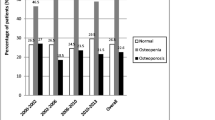Abstract
Introduction
Prior studies have documented suboptimal diagnosis and treatment for osteoporosis in many settings. Consistent predictors of suboptimal management include patient age, physician training, and physician gender. We assessed whether access to bone mineral density (BMD) testing was a predictor of osteoporosis management in an at-risk population of patients from New Jersey.
Methods
Based on health care claims data, we identified three groups of at-risk beneficiaries, including women ≥65 (n=8,283), men and women ≥45 with a fracture (n=740), and men and women ≥45 taking chronic oral glucocorticoids (n=616). As the outcome of interest, we determined whether beneficiaries had undergone a BMD test and/or filled a prescription for a medicine used for osteoporosis (alendronate, calcitonin, hormone therapy, etidronate, risedronate, raloxifene, teriparatide) during the period 1 September 2002–31 August 2004. We assessed the relationship between this outcome and access to BMD testing. Access was characterized using two different measures: (1) the estimated driving time between each beneficiary’s residence and the nearest BMD testing center (“driving time”) and (2) the number of persons ≥65 years of age per BMD testing machine (“BMD scanner ratio”) for each of the 21 counties in New Jersey.
Results
Of the 9,640 beneficiaries, we found that 3,104 (32%) had undergone a BMD test, 2,893 (30%) had filled a prescription for an osteoporosis medication, and 4,364 (45%) had one or both. Across the 21 counties of New Jersey, the percentage of at-risk patients who had a BMD test and/or medication for osteoporosis ranged from 38 to 52%. In models adjusted for patient factors and the clustering of patients in counties, driving time was not associated with patients being screened or treated for osteoporosis. The BMD scanner ratio was a weak predictor of osteoporosis management.
Conclusion
Among beneficiaries of one large health insurer in New Jersey, two different measures of access to BMD testing were not important predictors of receiving testing and/or medications for osteoporosis.



Similar content being viewed by others
References
Raisz LG (2005) Clinical practice. Screening for osteoporosis. N Engl J Med 353:164–171
Kanis JA (1994) Assessment of fracture risk and its application to screening for postmenopausal osteoporosis: synopsis of a WHO report. Osteoporos Int 4:368–381
Morris CA, Cabral D, Cheng H, Katz JN, Finkelstein JS, Avorn J, Solomon DH (2004) Patterns of bone mineral density testing: current guidelines, testing rates, and interventions. J Gen Intern Med 19:783–790
Solomon DH, Morris C, Cheng H, Cabral D, Katz JN, Finkelstein JS, Avorn J(2005) Medication use patterns for osteoporosis: an assessment of guidelines, treatment rates, and quality improvement interventions. Mayo Clin Proc 80:194–202
Morris CM, Cheng H, Cabral D, Solomon DH (2004) Predictors of osteoporosis management. Endocrinologist 14:70–75
Fisher ES, Wennberg JE, Stukel TA, Sharp SM (1994) Hospital readmission rates for cohorts of Medicare beneficiaries in Boston and New Haven. N Engl J Med 331:989–995
Hannan EL, van Ryn M, Burke J, Stone D, Kumar D, Arani D et al (1999) Access to coronary artery bypass surgery by race/ethnicity and gender among patients who are appropriate for surgery. Med Care 37:68–77
Kelaher M, Stellman JM (2000) The impact of medicare funding on the use of mammography among older women: implications for improving access to screening. Prev Med 31:658–664
US Department of Health and Human Services (2004) Bone Health and Osteoporosis: A Report of the Surgeon General. US Department of Health and Human Services, Office of the Surgeon General, Rockville, MD
Stinchcomb D (2006) Procedures for geomasking to protect patient confidentiality. Accessed at http://gis.esri.com/library/userconf/health04/papers/pap3012.pdf on March 31, 2006
ref http://quickfacts.census.gov/qfd/index.html accessed November 21, 2005
Solomon DH, Finkelstein JS, Katz JN, Mogun H, Avorn J (2003) Underuse of osteoporosis medications in elderly patients with fractures. Am J Med 115:398–400
Solomon DH, Brookhart MA, Gandhi TK, Karson A, Gharib S, Orav EJ, Shaykevich S, Licari A, Cabral D, Bates DW (2004) Adherence with osteoporosis practice guidelines: a multi-level analysis of patient, physician, and practice setting characteristics. Am J Med 117:919–924
Author information
Authors and Affiliations
Corresponding author
Additional information
Merck & Co., Inc. funded this research. Dr. Solomon is also supported by grants from the NIH (AR 48616, AG 027066), the Arthritis Foundation (Atlanta, GA), and the Engalitcheff Arthritis Outcomes Initiative (Baltimore, MD).
Rights and permissions
About this article
Cite this article
Solomon, D.H., Polinski, J.M., Truppo, C. et al. Access to bone mineral density testing in patients at risk for osteoporosis. Osteoporos Int 17, 1749–1754 (2006). https://doi.org/10.1007/s00198-006-0180-4
Received:
Accepted:
Published:
Issue Date:
DOI: https://doi.org/10.1007/s00198-006-0180-4




